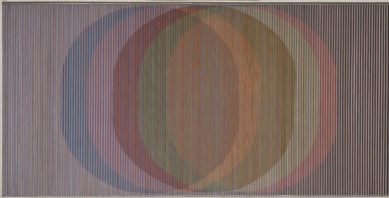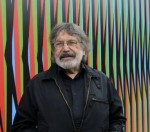
Carlos Cruz-Diez
Venezuelan, 1923-
Physichromie 352, 1967
cardboard, casein, cellulose acetate inserts mounted on wood
24 x 47 5/8 x 1 3/8 in.
SBMA, Gift of the ARCO Collection
1995.53.5

Undated photo of Cruz-Diez
“The world is in constant movement." - Carlos Cruz-Diez
RESEARCH PAPER
Physicromie 352 is an Op Art piece created by Venezuelan artist Carlos Cruz-Diez. The physicromie is a structure designed to reveal certain events and conditions related to color, which changes according to the movement of the viewer and the intensity of the light, and thus projecting color into space to create an evolutionary situation of that consists of additive, reflective, and subtractive color.
The Venezuelan was part of the Op art movement, which officially started in October of 1964 when the New York Times published an article announcing the birth of a new style of art. They baptized it as “Optical Art,” or “Op Art” as it is more commonly known today. It has its roots from the Bauhaus school borrowing from constructivism.
A movement with origins in Russia, Constructivism was primarily an art and architectural movement. It rejected the idea of art for arts' sake and the traditional bourgeois class of society to which previous art had been catered. Instead it favored art as a practice directed towards social change or that would serve a social purpose.
After its boom this kind of art was rapidly adopted in television, printing and advertising. Some of the main attributes of this style are that it uses the principles of optics in order to create an optical illusion in the viewers. To the human eye, it often appears to be moving or breathing due to its precise, geometrical and mathematically-based composition
In this art movement the artist organizes lines, forms, and space in such a way as to provide optical illusions of an ambiguous nature, like alternately advancing and receding squares on a flat surface. An important Op artist is Victor Vasarely (1908-1997). He is considered to have created the first piece of this innovative and revolutionary movement. This piece is a black and white work titled "Zebras."
The mediums used on Op Art are mainly paintings and digital works, rather than photography due to its difficulty in finding effective subject material. Another particularity of “Op Art” is that it has quite a profound effect on the eyes and sometimes is hard to look at for a long period of time. This profound effect on the eyes is something that can be experienced with "Physicromie 352” which creates an intense and excessive stimulation to the eyes and brain. The aesthetic goal of Cruz-Diez and his contemporaries was that Op Art should produced a multi sensorial impact in the spectator.
Soto was a Venezuelan artist and is considered one of the founders of kinetic art. He used to say that “the world is in constant movement,” which is why his work was based on capturing movement as well as using three-dimensional elements. These influences can be appreciated in “Physicromie 352.”
Just like Soto, Carlos Cruz-Díez studied at the School of Fine Arts of Caracas, where he later taught History of Applied Arts. He began studying the physical properties of color, developing his own theories during the 1950s.
It was during that time that the Venezuelan was extremely interested in optical phenomena. While experimenting with primary colors arranged in thin intersecting bands, he realized that he could create the illusion of a third or fourth color that was, in reality, not present.
From then on, Cruz-Diez based his work on a “non-traditional understanding of color.” He moved to Paris in 1960, exhibiting his “physicromies” in 1969, as part of his first personal exhibition.
This “physicromie ” is a dynamic piece composed of cardboard, acrylic paint, casein and cellulose acetate, and is a multimedia effort by the Cruz-Diez who before becoming an artist worked as a graphic designer. The four colors in “Physicromie 352” are blue, yellow, green and red.
With these colors as his starting point, he fragments the form of the painting, transforming a flat, painted surface into a succession of vertically positioned, parallel lines, that at the same time represent semi-circular shapes. These alternating and discontinuous geometric shapes emerge, intensify, change, and dematerialize, depending on the position and the movement of the spectator. This follows the artist’s conception that color evolves and changes in space and time.
The work is thus inscribed as an interpretation of movement and transformation attributed to the optical illusion provoked by the thin, transparent screens of cellulose acetate.
In this sense, the painter reveals the vibration of light and the infinite variety of colors perceptible in his inert images, making “Physicromie 352” a perfect, dynamic and interactive example of Op Art.
Prepared for Docent Council March, 2013 by Carlos Hernández
Bibliography
C. Cruz-Diez, M. Ramírez & H. Olea. (2011) Carlos Cruz-Diez: Color in Space and Time. Houston: Museum of Fine Arts of Houston.
F.Follin, C. Pias & M. Weinhart. (2007) Op Art. Köln: Walther König Bilingual Edition
J. Houston & D. Hickey. (2007) Optic Nerve: Perceptual Art of the 1960s. Merrell Publishers

Victor Vasarely, Zebra, 1937
COMMENTS
Carlos Cruz-Diez has lived and worked in Paris since 1960. His artistic roots reach back to the Movimiento Cinético [Kinetic Movement] of the 1950s and 1960s. As his thinking on the visual arts has evolved, his ideas have changed attitudes on how color is perceived in art. According to his artist’s statement, color is an autonomous reality, devoid of anecdotes, that evolves in real time and space with no need of form or support.
Carlos Cruz-Diez’s artistic proposal is based on eight research projects that reveal the myriad ways in which color behaves: Couleur Additive [Additive Color], Physichromie, Induction Chromatique [Chromatic Induction], Chromointerférence, Transchromie, Chromosaturation, Chromoscope, and Couleur dans l’espace [Color in Space].
Venezuelan painter and kinetic artist. He studied in 1940 and 1941 at the Escuela de Artes Plásticas y Aplicadas in Caracas, producing Socialist Realist paintings while working as art director to the McCann Erickson advertising agency in Venezuela, where he became interested in the effect of colour in advertising. In 1955–6 he visited Paris and Barcelona, where his interest was aroused by theories of geometric abstraction, scientific colour theory and Bauhaus ideas on the integration of the arts and crafts. On returning to Caracas he opened the Estudio de Artes Visuales, where he began to investigate the role of colour in kinetic art. Cruz-Diez’s wide experience in advertising, industrial applications of colour, cinema and photographic and photo-mechanical processes, together with his study of work by Georges Seurat and Josef Albers and of Edwin Land’s (b 1909) scientific ideas on colour perception, led him to produce such constructions as the Physichromy series, which was initiated in 1959, immediately after a group of geometric works based on the repetition and serialization of flatly painted trapezoids. The Physichromies explored additive, subtractive and reflective colour relationships that could be altered by the relative positions of the light source and viewer.
Physichromie (Caracas 1959)
The Physichromie is a structure designed to reveal certain circumstances and conditions related to color, changing according to the movement of the viewer and the intensity of the light, and thus projecting color into space to create an evolutionary situation of additive, reflective, and subtractive color.
http://www.cruz-diez.com/work/physichromie/
http://www.artfact.com/artist/cruz-diez-carlos-2uqq99z50z
Compiled for SBMA Docent Council by Loree Gold, 2013
SBMA CURATORIAL LABELS
Like Jesús Rafael Soto, whose work is also on view in this gallery, Cruz-Diez left Venezuela for Paris because of the political situation during the 1950s. In an interview, he recalled the military police showing up at an artists’ party and everyone feeling “like flies.” He said, “I was never very political. I once sat in a Communist Party meeting and realized that in order to join the party one has to be obedient—I’ve never been obedient.”
He relocated to Paris in 1960, worked as a graphic designer, and continued his experiments with color in the Physichromie series. Walk back and forth, and watch as the colors and patterns shift. You, the viewer, complete the work, and there is no correct angle from which to see it. As with many abstract artists in this exhibition, Cruz-Diez sought to make work that was wholly in the present, with no history, no cultural references. He said, “The Physichromies . . . force us to deal with an event of color happening in the moment, without past or future.”
- Going Global, 2022
A pioneer of Kinetic and Op art, Carlos Cruz-Diez worked as a commercial graphic designer after graduating from the Escuela de Bellas Artes de Caracas (Caracas School of Fine Arts). In 1960, he moved to Paris where he continues to live and work.
Cruz-Diez has approached his art as an ongoing series of optical experiments, manipulating color and light to produce sensory experiences. In the late 1950s he read articles by Edwin Land, inventor of the Polaroid camera, on creating the entire color spectrum from a combination of red and green monochromes. This literature was instrumental in the development of Cruz-Diez’s “Physichromie” series, which he began in Caracas in 1959 and continued to produce into 2011. The artist invented the term by combining words “physical” and “chromatism,” which he used to describe the effect produced when he placed colors in parallel strips and also at right angles to each other. The combination of colors, angles of refraction, and the movement of the spectator would produce what the artist described as “physical sensations of chromatic changes.” For Cruz-Diez, color is a constantly evolving situation rather than an objective fact.
SBMA label, 2013
